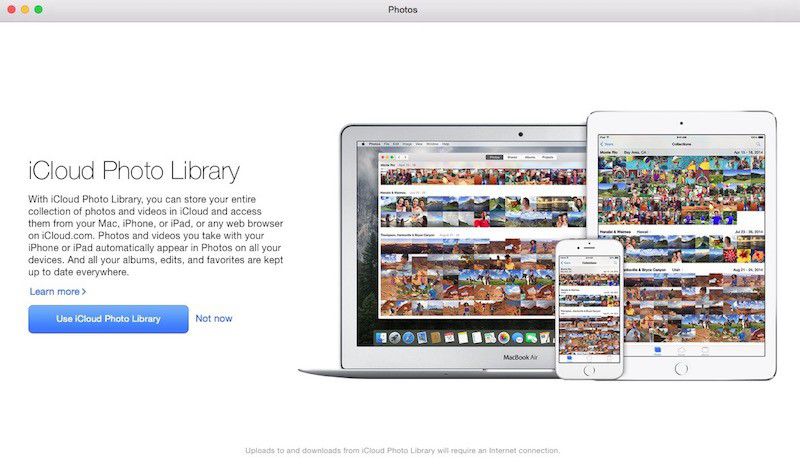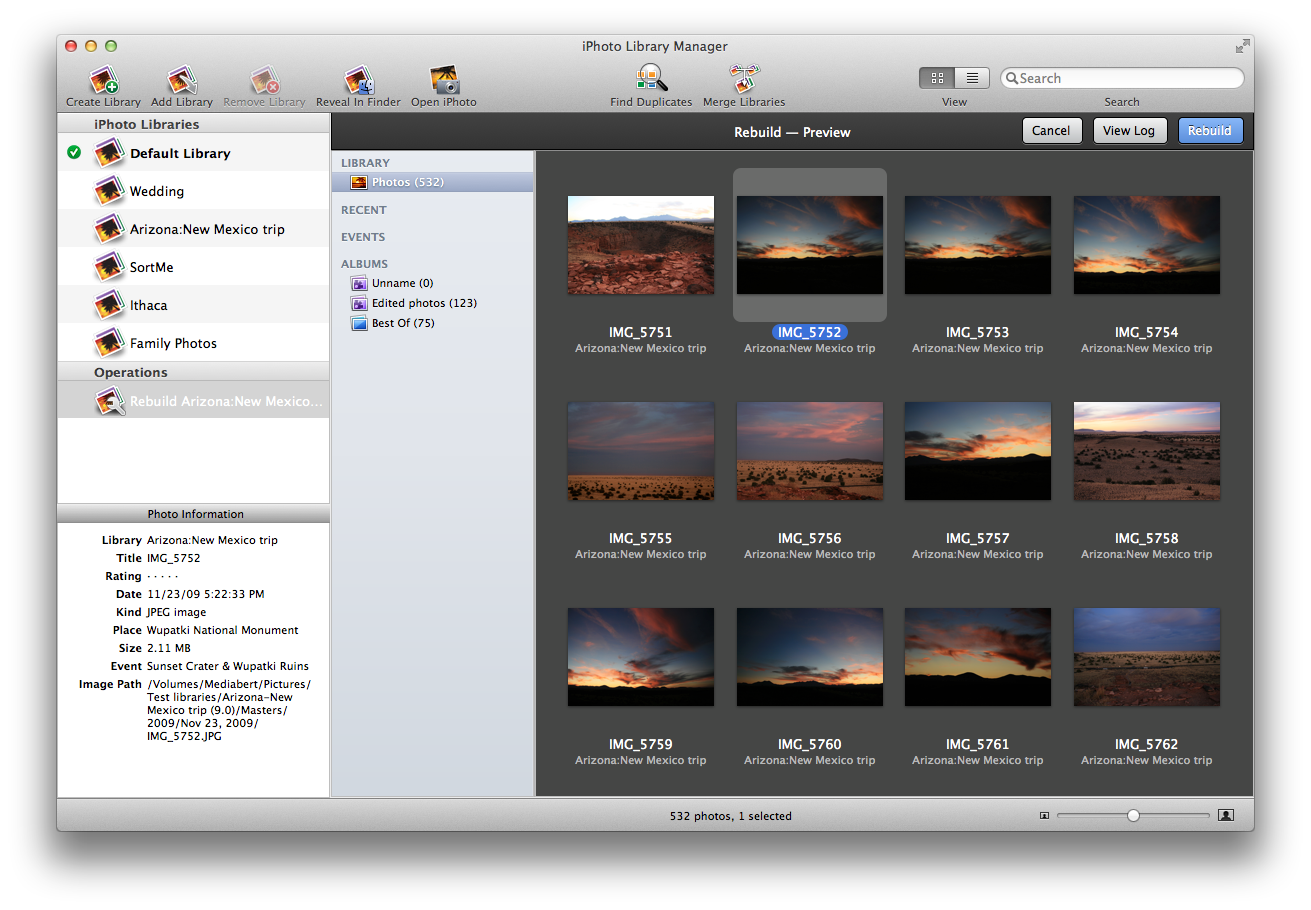May 01, 2010 What I thought was since Aperture 3 can't read my iphoto library, is if I could use the migration assistant to get my iphoto library transferred to my mbp. Then import the files into aperture 3 on my mbp then save the library to an external drive to then re-import the APerture 3 library I created on my mbp back to my imac.
- How To Transfer Iphoto Library To New Macbook
- Best Way To Move Iphoto Library To New Mac
- Copy Iphoto Library To Windows
- Move Iphoto To Photos
Check that you migrated the correct library
If you have more than one library in your Pictures folder, Photos will ask you to choose a library to migrate the first time you open the app. This library becomes the default library, and contains the pictures Photos will display every time you open the app.
If you choose a different library the first time you open Photos — for example, an older iPhoto library — you might not see all the pictures you expect. You can migrate another library by holding down the Option key when you open Photos. This brings up the Choose Library dialog, which lets you select from the available photo libraries in your Pictures folder:
Click My Albums in the sidebar to see all your albums
The first time you open Photos, you'll see your pictures in the Moments view. This view shows your pictures individually, but doesn't show your albums. To see them, click My Albums in the Photos app sidebar.
Find iPhoto Events that have become albums
When you migrate an iPhoto library to Photos, iPhoto Events are turned into albums. You can find these albums in a folder called iPhoto Events in Photos' Albums view.

Turn on My Photo Stream
If you had pictures more than 30 days old in My Photo Stream that you didn't import into iPhoto or Aperture before moving the library to Photos, those pictures won't appear in Photos.
If you recently created your Apple ID, My Photo Stream might not be available. If My Photo Stream isn't available, use iCloud Photos to keep your photos and videos in iCloud.
You can turn on My Photo Stream in Photos with these steps:
- In the menu bar, choose Photos > Preferences.
- In the Preferences window, click the iCloud tab.
- Click My Photo Stream.
Wait for Photos to generate all picture thumbnails
When you migrate a library to Photos, it can take some time to generate thumbnails for the entire library. A picture will appear as a white square until its thumbnail is created.
Learn how Photos displays Smart Albums and RAW + JPEG image pairs
Photos displays some Smart Albums differently than the program that created them. Learn more about How Photos displays Smart Albums from iPhoto or Aperture.
If your Aperture library included RAW + JPEG image pairs, only the JPEG file will be visible in Photos.
View all burst pictures
Sets of pictures taken in burst mode with your iPhone are displayed with a single thumbnail in Photos. To see all the pictures from the burst, double-click the thumbnail and then click 'Make a Selection…'
Learn more
After you update to Photos for macOS, turn on iCloud Photos to keep your photos and videos securely stored in iCloud and up to date on your iPhone, iPad, iPod touch, Mac, Apple TV, and iCloud.com.
Wondering, “Where does iPhoto store photos?” Well, in this post, you will get to know about the location where it stores your photos, and how find photos on Mac.
Common iPhone Data Tips
iPhone Video & Music Tips
iPhone Photo Tips
iPhone Contact Tips
Without any doubts, iPhoto is a useful picture management application by Apple. The app was present in a Mac computer, but it replaced with Photos application in 2015. However, whenever users import photos into iPhoto, the app makes copies of their photos and leaves original files somewhere else where users can’t access easily.
No matter for what reasons you want to know the location where iPhoto stores original pictures whether for backup purpose or to transfer them into another application, you can refer to this guide. Here, we are going to show you where iPhoto stores photos in detail. Also, you will get to learn on how to find photos on Mac computer.
Part 1: Where Does iPhoto Store Photos
So, let’s begin: iPhoto stores your pictures copies in a special folder known as “iPhoto Library”. You can locate in your Mac Home folder and then, Pictures folder. Here are the detailed steps to find the location where iPhoto stores photos:
Step 1 To begin the process, go to the “Finder” in your Mac computer and after that, navigate to your Home directory.
Step 2 Thereafter, if you log-in to your Mac computer with the name “Alex”, the full path to the folder “iPhoto Library” would be Mac HD > Users > Alex > Pictures > iPhoto Library. And right-click on the folder, and then, choose the “Show Package Contents” option.
Where Does iPhoto Store Photos
Step 3 When you reach your iPhoto Library folder, you will see a set of files and folders organised with numbers. All these numbers you see are the originals files creation dates. Look at the below figure to understand.
However, if you are now using an iPhoto newer version known as Photos, then you can locate the photos in a similar way as described above. But, you have to locate the “Photo Library” folder instead of “iPhoto Library” folder. And then, tap on “Masters” to view your pictures set in folders by date.
Part 2: How to Find Photos on Mac and Transfer Photos to Mac
No doubt, iPhoto or Photo application allows you to view pictures on Mac. But, what if you want to transfer photos from iPhone to Mac? Don’t worry as AnyTrans for iOS is here for you. It is mainly designed for iOS data management and transfer. With the help of it, you can manage your iPhone files including photos on Mac easily. Here are its main features and advantages on photos management:
- Transfer any type of photos: With the help of it, you can move photos in Photo Stream, Camera Roll, Photo Library, Photo Share and Albums from your iPhone to Mac.
- Support selective transfer: It allows you to move all photos in one go or only selected photos to your Mac.
- Multi-directional transfer: It allows you to migrate files from computer to iPhone also, and there will be no data and quality loss during transfer.
- Supports all data types: No matter whether you want to move photos, audios, videos, apps, contacts, or any other data type from your iPhone to Mac, it can do it with ease.
Now, Free Download AnyTrans for iOS on your computer, and then follow the step-by-step guide to view and transfer photos from iPhone to Mac effortlessly.

Free Download * 100% Clean & Safe
Step 1: Connect your iPhone and Mac.
To begin the process, launch the software on your Mac. Then, run it and connect your iPhone to a computer with the help of a digital cable. Next, move to the file category” page as shown in the figure.
How to Find Photo Files on Mac- Step 3
Step 2: Select photo category to transfer.
After that, select “Photos” and then, choose a photo type you want to move to your Mac computer from iPhone. Let’s take an example of Camera Roll.
How to Find Photos on Mac with AnyTrans for iOS – Step 2
Step 3: Transfer photos from iPhone to Mac.
Here, choose the desired pictures you want to move and finally, click on the “Send to Mac button as shown in the figure.
How To Transfer Iphoto Library To New Macbook
After the process completes, you can view the transferred photos on your Mac.
How to View Photos on Mac

The Bottom Line
Best Way To Move Iphoto Library To New Mac
That’s all on how to find photo files on Mac and how to transfer them to Mac. Hopefully, this guide helps you to find the location of your iPhoto/Photo original files. However, give a try to AnyTrans for iOS software by downloading and installing it on your PC, and manage your iPhone data in a better and efficient way.
More Related Articles
Copy Iphoto Library To Windows
Popular Articles & Tips You May Like
Move Iphoto To Photos
Product-related questions? Contact Our Support Team to Get Quick Solution >